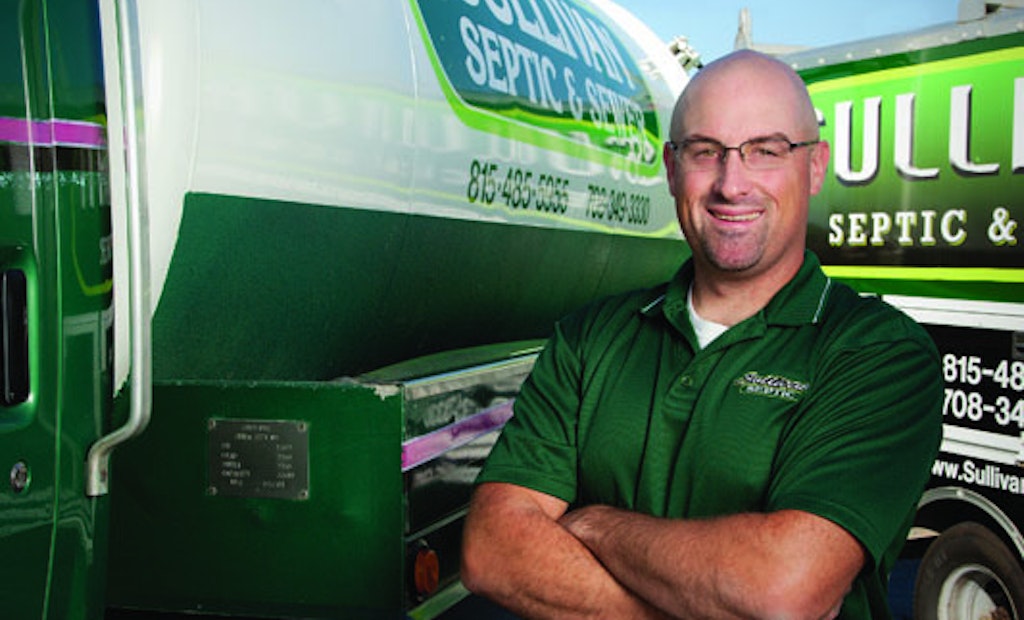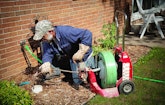
Interested in Onsite Systems?
Get Onsite Systems articles, news and videos right in your inbox! Sign up now.
Onsite Systems + Get AlertsRyan Murphy invested a lot of time and effort working toward the law enforcement career he was passionate about. “I loved being a cop. Federal law enforcement was my goal,” Murphy says about his time working for the Downers Grove Police Department in suburban Chicago.
But then there was another passion of Murphy’s: The wellbeing of his extended family and the blood, sweat and tears they invested in a long-held and successful septic service business.
In life, things happen and priorities change. For Murphy, it was a pending marriage and his uncle’s terminal illness that led to his decision to become the fourth generation to own and run the family’s Sullivan Septic and Sewer Inc. in New Lenox, Ill. “This is something I kind of always wanted to do and always saw myself doing, even as a kid,” he says. “It’s weird how things turned out.”
In failing health in 2004, Mike Hinsberger asked Murphy to take over the business founded in 1945 by Ray Sullivan, and later owned by Gene Mulcrone and then turned over to Hinsberger — all of them uncles and nephews to each other. Though police work provided many rewards, Murphy has discovered deeper satisfaction and a source of great pride in carrying on a family tradition and serving so many friends and neighbors.
GETTING THE JOB DONE
Sullivan is a well-established company, maintaining a base of 8,000 to 10,000 customers. Along with pumping, the company offers design, installation and repair of septic and sewer lines, and general excavation.
Septic system installation and repair accounts for about 70 percent of annual revenue, with a typical year including 70 to 100 installation projects. Most utilize conventional Infiltrator Systems or Advanced Drainage Systems chambers with Infiltrator tanks. Murphy also installs a lot of AdvanTex AX20 advanced systems by Orenco Systems. Most installations have large drainfields due to poor soils and high groundwater. “For a three-bedroom home, we’ll put in a 1,000-gallon tank and 800 to 1,000 feet of trench,” he says. “I did a church last year that was 8,000 feet of trench.”
Septic inspections are performed on request. “My inspections are a little more detailed than most,” he says, adding that what often passes for an inspection in his area is a simple dye test.
“That’s not an inspection; that’s just taking someone’s money. An inspection is uncovering the tank, digging up a section of the drainfield or a distribution box, and putting a camera down the line.”
With his Spartan PROvision digital camera, Murphy has found situations in which a home may have modern PVC plumbing inside, but is connected to old clay pipes.
He uses a small, 3-foot Milwaukee telescoping camera for tank inspections. “You can look at the tank walls and seams,” Murphy says. “The tank is full of water, but you can see a little more detail.”
His fleet of equipment includes, a 1998 Ford Sterling vacuum truck with a 3,300-gallon aluminum tank and an NVE (National Vacuum Equipment) 367 Challenger vacuum pump added by Advance Pump & Equipment. He is looking for a new vacuum truck, and plans to add a jetter and heated valves. The company’s service truck is a 1998 Chevrolet van with a fiberglass Spartan service body. The rest of the fleet includes a 2000 Sterling tandem axle dump truck; 2007 Caterpillar 420E backhoe loader; 2004 Bobcat T300; 2000 New Holland L185 skid-steer; and a 2007 Chevrolet Silverado 2500 pickup.
TOUTING TECHNOLOGY
Wife Carissa, a certified public accountant, handles the books. With her husband’s career change, she was able to quit her outside job and be home with the children and serve a critical role in the family business.
Most of the staff is like family, too. Joe Threm has been there for 28 years and handles installations, inspection and service. “He knows more than me,” says Murphy. The vacuum truck is driven by Jake Stout, with the company for only two years, but whom Murphy has known since Stout was a baby. A plumber by trade, Stout also helps out on some installations.
Customer records have been computerized in TAC (Total Activity Control) from Clear Computing, Inc. to help in both scheduling and customer service. The system generates reminder notices for customers who need pumping and allows drivers to schedule appointments. Through new technology, secretary Debbie Steuben, with the company for 20 years, can access records instantly, even from home, and can more easily communicate with Murphy through texting.
“I keep a laptop or iPad in my truck and carry a smartphone,” he notes. A mobile hotspot in his truck allows Internet access over a cellphone connection. He plans to add such technology to all his trucks to improve efficiency.
His customer base includes many seasonal homes and rental properties owned by out-of-state customers, so the digital tools come in handy. “We have them on an automated schedule and we have their credit card information. We just pump them out, send the bill, and it’s already been paid,” he says.
Email is also very helpful for absent customers. When a rental property had a problem, the work was approved and scheduled by email. “We pulled a huge 3-foot root out of the pipe,” Murphy says. “I could have told him it was tree roots. Instead, I sent him the pictures and video.”
EDUCATING CUSTOMERS
Murphy posted the tree root photos and video on his Facebook page, along with pictures of a sludge-filled distribution box caused by not pumping a septic tank, hints on septic care, installation pictures, and a few videos.
Murphy says such technologies can help educate people. “A lot of customers don’t understand septic systems. They have no idea what it is, how it works, or what it can or cannot do.”
Such tools also supplement marketing efforts, such as signs around town and his trucks. “I’ve done a few local parades and we do a local event called Touch a Truck,” he says. “We let the kids jump around on the trucks and tractor and beep the horn.” But word-of-mouth and personal relationships are still king.
“I meet every customer face-to-face and go out on every job,” Murphy says. “I do all the bidding and layout. I like being directly involved with customers.”
Murphy sees a further greening of the onsite wastewater industry in the future. “Systems will be getting much more efficient,” he says. Even with increasing regulation, Murphy says there is still no reason that septic systems shouldn’t be a viable solution to wastewater challenges. Health departments can help by making sure they require good technology.
FACING DISPOSAL CHALLENGES
Currently about 70 percent of his septage is disposed of through land application, and 30 percent goes to wastewater plants, but Murphy anticipates land spreading will shrink through both regulation and dwindling farmland. That means more disposal at sewage plants will be needed. “The sanitary districts have to make it more accessible,” he says. He says it costs, on average, $200 to dispose of a 3,000-gallon tank at the plants in his area.
Traveling to a disposal plant also chews up a lot of time, especially since they have to drive in Chicago traffic. The closest receiving station is a 30-minute drive; another plant is the same distance away, but is a 90-minute trip. “In rush hour, forget it. You’d be there for three or four hours,” says Murphy.
As for his company, growth may be in the cards sometime in the future, but he’s happy with where the company is right now. And he thinks Uncle Mike would be happy too.










